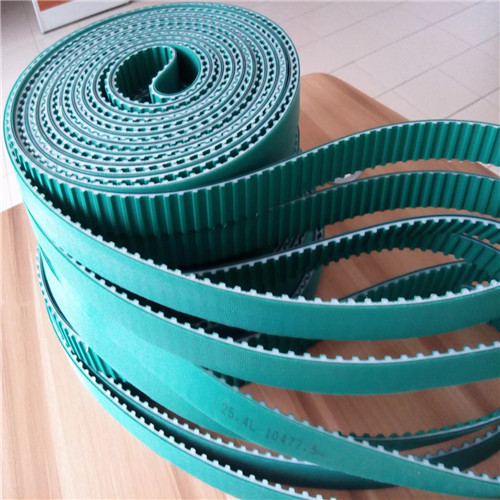Synchronous belts, also known as timing belts, often experience breakage due to a variety of factors that compromise their structural integrity and functionality. Here are some typical causes and associated corrective measures:

1.Overload or Impact Loading: Excessive force or sudden shock loads can lead to immediate or progressive failure of the belt. To address this issue, it is crucial to verify the design specifications, select a belt with appropriate width and strength for the given load capacity, and monitor the system to prevent unexpected overloads or shocks.
Countermeasure: Check and optimize the design to ensure the belt can handle the anticipated operational loads. Implement load monitoring systems or overload protection mechanisms to prevent excessive stress on the belt.
2.Small Pulley Diameter: A pulley diameter that is too small may result in excessive bending stress on the belt, causing deformation or cracking. Increasing the pulley size helps distribute the load more evenly and reduces stress concentrations.
Countermeasure: Redesign the drive system using larger diameter pulleys that are better suited to the belt type and the desired operational speed and torque requirements.
3.Excessive Inertia of Driven Components: If the inertia of the driven wheels or shafts is too high, it can put undue strain on the belt during rapid accelerations and decelerations.
Countermeasure: Optimize the mass moment of inertia of the driven components or consider implementing additional support bearings or gear reduction to reduce the load on the belt.
4.Incorrect Tension: Over-tightening or insufficient tension can lead to excessive flexing or slipping, respectively, both of which can contribute to belt failure.
Countermeasure: Regularly inspect and adjust the belt tension to the manufacturer’s recommended levels. Use tension indicators or measuring tools to ensure correct tension is maintained throughout the belt’s lifecycle.
5.Misalignment or Bent Pulleys: Misaligned pulleys or bent pulley shafts can cause uneven loading on the belt and lead to accelerated wear and tear.
Countermeasure: Ensure proper alignment of the pulleys and periodically check for warping or bending. Correct misalignments immediately and replace damaged pulleys.
6.Foreign Objects or Contamination: The presence of foreign objects like chips, dust, or debris can get lodged in the belt, leading to tears or cuts.
Countermeasure: Maintain a clean operating environment, install protective guards, and implement regular cleaning schedules to prevent contamination.
7.Environmental Factors: Exposure to harsh chemicals, extreme temperatures, or UV radiation can degrade the belt material over time, weakening it and increasing the risk of breakage.
Countermeasure: Choose belts made from materials suitable for the operating environment, apply protective coatings when necessary, and replace belts that show signs of material degradation.
8.Installation Errors: Incorrect installation methods, such as cutting the belt improperly or failing to seat it correctly on the pulleys, can lead to early failure points.
Countermeasure: Follow manufacturer instructions carefully during installation and perform routine checks to ensure the belt remains seated correctly and has no kinks or twists.
9.Age and Wear: Long-term usage can lead to natural wear and tear, including material fatigue and embrittlement, resulting in eventual belt failure.
Countermeasure: Establish a preventive maintenance program to regularly inspect belts for signs of wear and replace them before they reach the end of their service life.
By addressing these common causes and applying the suggested countermeasures, users can significantly reduce the likelihood of synchronous belt failures and extend the lifespan of the belts in their applications.